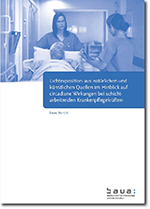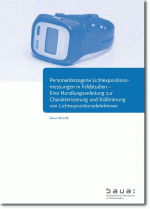Light exposure from natural and artificial sources with regard to circadian effects in shift-working nurses
(in German)
Shift work which disturbs the synchronization of circadian physiological processes in the human body with natural 24-hour day-night rhythm, is associated with a number of diseases. Since the identification of a new non-visual photoreceptive mechanism that is active in regulating physiological processes, the influence of light on the circadian rhythms has been often investigated under laboratory conditions. Research of personal light exposures in field studies is also of great importance to support better understanding of a possible connection between shift work and health risks.
A total of 85 nurses from the Klinikum Dortmund and the King's College Hospital in London took part in the joint study by the Federal Institute for Occupational Safety and Health (BAuA) and the Public Health England (PHE). The 42 nurses in Dortmund were either shift workers who worked in three 8-hour shifts (early, late and night shift) or 8-hour daytime working nurses. The 43 nurses in London did either a 12-hour shift (day and night shift) or regular 8-hour working days. The nurses recorded light exposure both during and outside working hours continuously for a week in three seasons (winter, spring and summer) using a detector worn at chest level.
The goal was to identify the characteristic features of the light exposure of this profession. To estimate the light exposure as it relates to the non-visual system, the light exposure in the blue spectral range was considered. In addition, the illuminance was recorded, which is decesive for the influence of light on the visual system. The following applies to the two light exposures:
- Working time-related and seasonal differences in light exposure are clearly recognizable in both Dortmund and London, despite large intra- and interindividual differences.
- The light exposure on working days is essentially determined by the working hours and reaches its maximum values during the journey to and from the workplace, whenever this includes exposure to daylight.
- The light exposure from artificial lighting sources indoors at work and at home is much lower than the relatively short-term exposure to natural daylight outdoors.
- While the 8-hour early and late shift in Dortmund and the 8-hour daytime work in Dortmund and London enabled higher light exposures, at least on the way to work or home, the average light exposure on 12-hour day shifts in London is very low all year round, due to the nurses being at work for the whole day. This could lead to a disturbance in circadian rhythms such as of the sleep-wake rhythm.
- While seasonal differences in light exposure between winter and summer are clearly recognizable, differences between spring and summer strongly depend on the respective weather conditions.
Please download the complete report "Light exposure from natural and artificial sources with regard to circadian effects in shift-working nurses" (in German only).
Bibliographic information
Title: Personenbezogene Lichtexpositionsmessungen in Feldstudien - Eine Handlungsanleitung zur Charakterisierung und Kalibrierung von LichtexpositionsdetektorenLichtexposition aus natürlichen und künstlichen Quellen im Hinblick auf circadiane Wirkungen bei schichtarbeitenden Krankenpflegekräften.
1. edition. Dortmund: Bundesanstalt für Arbeitsschutz und Arbeitsmedizin, 2020. pages: 58, Project number: F 2355, paper, PDF file, DOI: 10.21934/baua:bericht20200406

